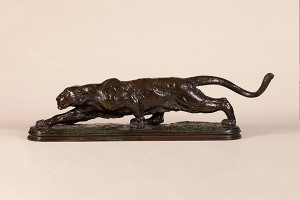
David Hockney, "Woldgate Woods, 26, 27 & 30 July 2006", Oil on 6 Canvases (36 X 48" Each), 72 x 144" overall © David Hockney, Photo Credit: Richard Schmidt
Hockney in Frisco, The West on Fifth, Swartz at SMOCA
Three Exhibits To See in January.
David Hockney: A Bigger Exhibition
Through January 20, 2014
Years, they start passing faster than they used to. I believe it was 2010 when I went with my New York pal JB to Pace Gallery in Chelsea to see what David Hockney was making of his tooling around in Yorkshire, England then externalizing the landscape into frames of paint. Huge canvases, multiple parts. The colors! Magenta trees. Acid green, one of my favorite colors, describing what is a deciduous, water-fed surround — without recourse to verisimilitude.
One only has until January 20th to see “David Hockney: A Bigger Exhibition,” at San Francisco’s de Young Museum. This exhibit was curated and organized by the artist’s long-time curator and business manager, Gregory Evans. We know about Hockney and scale and Hockney and fragment, reconstituted into dynamic visual choreographies. But maybe seeing what he did through 300 works — drawings first made on his iPad, at Yosemite; that psychedelic turquoise sea beyond the rock where a prophet is discoursing to shepherds — will make you see how this artist remains expert at working on the edge of anything bright and liminal, interpreted by his own Pantone imagination. See it in San Francisco as “A Bigger Exhibition” will not travel.
The American West in Bronze, 1850-1925
December 18, 2013 – April 13, 2014
“The American West in Bronze” was organized by the Metropolitan Museum of Art in New York in concert with Denver Art Museum where the show will open on May 11, 2014.
In Boston in late October, perusing The New York Times on a Sunday, I read about the 65 bronze sculptures in the exhibit, which seems on its surface to want to express a new interpretation of western sculptures of cowboy, Indian, pioneer and livestock genres, as causative in the “socio-cultural transformation of the American West.” The claim that it’s a “first” to see the art this way seems a big one for a type of art which, even though infrequently assembled in large numbers at New York’s Met, is shown constantly in Denver and Santa Fe (and at the annual Coeur d’Alene [Idaho] Art Auction that grossed $30.5 million in 2013).
Yet consider the work. Frederic Remington’s “Bronco Buster” with its taut lines of reins and stirrups and a horse body sinewy and mannerist. Alexander Phimister Proctor’s “Stalking Panther” which illumines the anatomy of the figure and in effect takes the face to a brute mask of concentration on satiating appetite. I still get a small case of hives at hearing the assignment of the word “first” around western art in New York. But what do I know? Go see for yourself, in New York or Denver, or read the catalogue, and please post a comment for AdobeAirstream readers.
Julianne Swartz: How Deep Is Your
Through January 26, 2014
Any show title that borrows with the first phrase of a Bee Gees song, face it, you gotta love. “Julianne Swartz: How Deep Is Your” names an exhibit at Scottsdale Museum of Contemporary Art that was co-organized by deCordova Sculpture Park and Museum (Lincoln, Mass.) and SMoCA. It assembles photographs and seven site-specific installations.
So many artists say they “transform” space; this person really does. She uses humor and whimsy. You might see Dr. Seuss or construe varietals of anime dance moves. Her colored thread, colored wires and tiny speakers more or less propose that provisional and compelling nexus of linkages between art historical then, and now. News flash to all who think Eva Hesse was really cool but tend to do the remix heavy on the mimesis and light on the ideation. Not so Julianne Swartz. Subtly, but subtly, she manages to simultaneously invoke Hesse and freshen the message.






